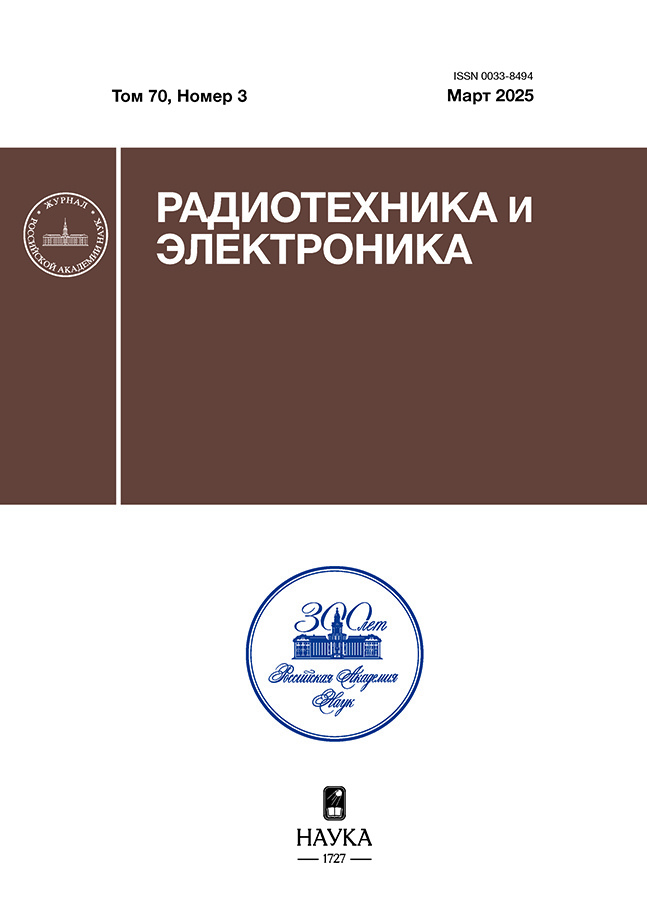A method for calculating errors in measuring the angular coordinates of a radar target presented as a multipoint model
- Authors: Gavrilov K.Y.1, Zlobin S.L.2, Malashko Y.I.2
-
Affiliations:
- Moscow Aviation Institute (National Research University)
- Public Joint Stock Company Scientific and Production Association “Almaz” named after Academician A.A. Raspletin
- Issue: Vol 70, No 3 (2025)
- Pages: 209-221
- Section: СТАТИСТИЧЕСКАЯ РАДИОФИЗИКА
- URL: https://jdigitaldiagnostics.com/0033-8494/article/view/686939
- DOI: https://doi.org/10.31857/S0033849425030029
- EDN: https://elibrary.ru/FWDTCE
- ID: 686939
Cite item
Abstract
The problem of determining errors in measuring angular coordinates (angular noise) of a radar target presented as a multipoint model is considered. A method for calculating errors in the angular coordinates of targets is proposed, which is based on determining the gradient of the phase field of the wave at the point of reception of reflected signals. Analytical relations have been obtained that make it possible to calculate the direction of arrival of waves with an arbitrary number and location of points in a multipoint target model. For various types of targets — low-flying, group and single targets with a different number of points, calculations of errors in the angles of arrival of radio waves were carried out. In this case, angular errors are understood as the deviation of the direction of arrival of reflected radio waves from the direction of the geometric center of the target. The analysis of the causes of abnormal errors in measuring angles for the considered cases of numerical calculations is carried out.
Full Text
About the authors
K. Yu. Gavrilov
Moscow Aviation Institute (National Research University)
Author for correspondence.
Email: gvrk61@mail.ru
Russian Federation, Moscow
S. L. Zlobin
Public Joint Stock Company Scientific and Production Association “Almaz” named after Academician A.A. Raspletin
Email: gvrk61@mail.ru
Russian Federation, Moscow
Ya. I. Malashko
Public Joint Stock Company Scientific and Production Association “Almaz” named after Academician A.A. Raspletin
Email: gvrk61@mail.ru
Russian Federation, Moscow
References
- Локк А.С. Управление снарядами. М.: Гостехтеориздат, 1957.
- Howard D.D. // Proc. National Electronic Conf. 1959. P. 840
- Бартон Д. Радиолокационные системы. М.: Военное издательство, 1967.
- Barton D.K. Radar System Analysis and Modeling. Boston: Artech House, 2005.
- Справочник по радиолокации / Под ред. М.И. Сколника. В 2-х книгах. Кн. 1. М.: Техносфера, 2014.
- Островитянов Р.В., Басалов Ф.А. Статистическая теория радиолокации протяженных целей. М.: Радио и связь, 1982.
- Теоретические основы радиолокации / Под ред. Я.Д. Ширмана. М.: Сов. радио, 1970.
- Финкельштейн М.И. Основы радиолокации. М.: Радио и связь, 1983.
- Richards M.A. Fundamentals of Radar Signal Processing. N. Y.: McGraw-Hill, 2013.
- Моделирование и обработка радиолокационных сигналов в Matlab. Учебное пособие / Под ред. К.Ю. Гаврилова. М.: Радиотехника, 2020.
- Бакулев П.А., Джавадов Г.Г., Соколов Д.А. // Изв. вузов. Радиоэлектроника. 1991. № 1. С. 3.
- Seçluk B. Target Glint Phenomenon Analysis and Evaluation of Glint Reduction Techniques. M.S. Thesis. Ankara: Middle East Technical Univ. 2012, 101 p. http://etd.lib.metu.edu.tr/upload/12614679/index.pdf
- Комяков П.О. // Матер. XIII Междунар. научн.-техн. конф. “Актуальные проблемы электронного приборостроения” (АПЭП). Новосибирск. 22–23 сент. 2016, Новосибирск: НГТУ, 2016, Т. 12. С. 32.
- Степанов М.А., Киселев А.В. Моделирование угловых шумов радиолокационных объектов. Новосибирск: Изд-во НГТУ, 2020.
- Злобин С.Л. Способ определения высоты полета низколетящей цели моноимпульсной РЛС сопровождения. Патент РФ на изобретение № 2761955. Опубл. офиц. бюл. “Изобретения. Полезные модели” № 35 от 14.12.2021 г.
- Злобин С.Л. Способ высокоточного определения высоты полета низколетящей цели моноимпульсной РЛС сопровождения. Патент РФ на изобретение № 2779039. Опубл. офиц. бюл. “Изобретения. Полезные модели” № 22 от 30.08.2022 г.
- Злобин С.Л. Способ определения высоты полета низколетящей цели моноимпульсной РЛС сопровождения в реальном масштабе времени. Патент РФ на изобретение № 2816168. Опубл. офиц. бюл. “Изобретения. Полезные модели” № 9 от 26.04.2024.
- Житник С.В., Степанов М.А. //Докл. Академии наук высшей школы РФ. 2022. № 3(56). С. 31.
- Miao Sui, Xiaojian Xu // J. Systems Engineering and Electronics. 2024. V. 25. № 3. P. 411.
- Yin Hongcheng, Huang Peikang, Xiao Zhihe // J. Systems Engineering and Electronics. 1996. V. 7. № 3. P. 1.
- Yin Hongcheng, Wang Chao, Huang Peikang // J. Radars. 2014. V. 3. № 2. P. 119.
Supplementary files




















